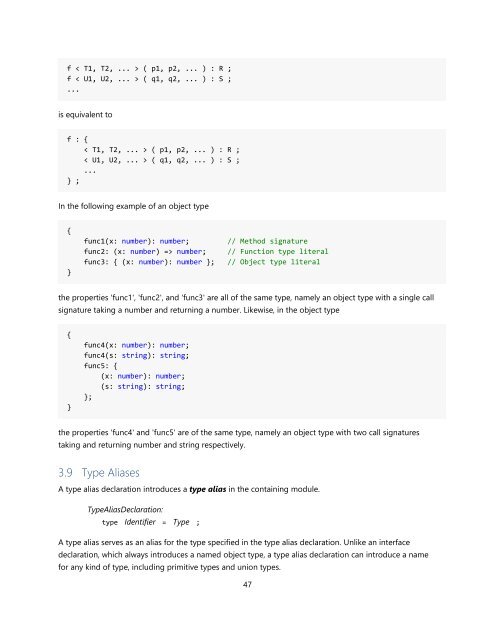TypeScript Language Specification v1.5
TypeScript Language Specification v1.5
TypeScript Language Specification v1.5
Create successful ePaper yourself
Turn your PDF publications into a flip-book with our unique Google optimized e-Paper software.
f < T1, T2, ... > ( p1, p2, ... ) : R ;<br />
f < U1, U2, ... > ( q1, q2, ... ) : S ;<br />
...<br />
is equivalent to<br />
f : {<br />
< T1, T2, ... > ( p1, p2, ... ) : R ;<br />
< U1, U2, ... > ( q1, q2, ... ) : S ;<br />
...<br />
} ;<br />
In the following example of an object type<br />
{<br />
}<br />
func1(x: number): number;<br />
func2: (x: number) => number;<br />
func3: { (x: number): number };<br />
// Method signature<br />
// Function type literal<br />
// Object type literal<br />
the properties 'func1', 'func2', and 'func3' are all of the same type, namely an object type with a single call<br />
signature taking a number and returning a number. Likewise, in the object type<br />
{<br />
}<br />
func4(x: number): number;<br />
func4(s: string): string;<br />
func5: {<br />
(x: number): number;<br />
(s: string): string;<br />
};<br />
the properties 'func4' and 'func5' are of the same type, namely an object type with two call signatures<br />
taking and returning number and string respectively.<br />
3.9 Type Aliases<br />
A type alias declaration introduces a type alias in the containing module.<br />
TypeAliasDeclaration:<br />
type Identifier = Type ;<br />
A type alias serves as an alias for the type specified in the type alias declaration. Unlike an interface<br />
declaration, which always introduces a named object type, a type alias declaration can introduce a name<br />
for any kind of type, including primitive types and union types.<br />
47


















